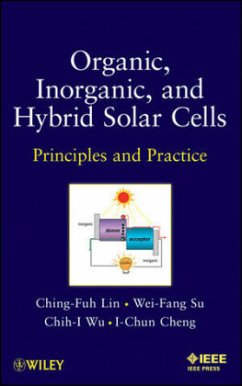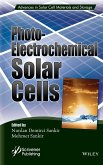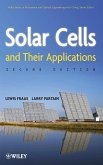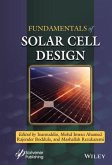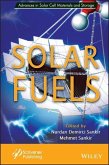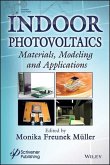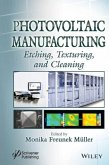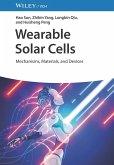Ching-Fuh Lin, Wei-Fang Su, Chih-I Wu, I-Chun ChengPrinciples and Practice
Organic, Inorganic and Hybrid Solar Cells
Principles and Practice
By Lin, Ching-Fuh; Su, Wei-Fang; Wu, Chih-I; Cheng, I-Chun
Ching-Fuh Lin, Wei-Fang Su, Chih-I Wu, I-Chun ChengPrinciples and Practice
Organic, Inorganic and Hybrid Solar Cells
Principles and Practice
By Lin, Ching-Fuh; Su, Wei-Fang; Wu, Chih-I; Cheng, I-Chun
- Gebundenes Buch
- Merkliste
- Auf die Merkliste
- Bewerten Bewerten
- Teilen
- Produkt teilen
- Produkterinnerung
- Produkterinnerung
Provides detailed descriptions of organic, inorganic, and hybrid solar cells and the latest developments in the quest to produce low-cost, long-lasting solar cells
What will it take to transform solar energy from an important alternative source to a truly competitive and, perhaps, dominant one? Lower cost and longer life. Organic, Inorganic, and Hybrid Solar Cells: Principles and Practice provides in-depth information on the three types of existing solar cells, giving readers a good foundation for evaluating the technologies with the most potential for competing with energy from fossil…mehr
Andere Kunden interessierten sich auch für
![Photoelectrochemical Solar Cells Photoelectrochemical Solar Cells]() Photoelectrochemical Solar Cells255,99 €
Photoelectrochemical Solar Cells255,99 €![Solar Cells 2e Solar Cells 2e]() Larry D. PartainSolar Cells 2e207,99 €
Larry D. PartainSolar Cells 2e207,99 €![Fundamentals of Solar Cell Design Fundamentals of Solar Cell Design]() Fundamentals of Solar Cell Design254,99 €
Fundamentals of Solar Cell Design254,99 €![Solar Fuels Solar Fuels]() Solar Fuels264,99 €
Solar Fuels264,99 €![Indoor Photovoltaics Indoor Photovoltaics]() Indoor Photovoltaics219,99 €
Indoor Photovoltaics219,99 €![Photovoltaic Manufacturing Photovoltaic Manufacturing]() Photovoltaic ManufacturingPhotovoltaic Manufacturing206,99 €
Photovoltaic ManufacturingPhotovoltaic Manufacturing206,99 €![Wearable Solar Cells Wearable Solar Cells]() Hao SunWearable Solar Cells95,99 €
Hao SunWearable Solar Cells95,99 €-
-
-
Provides detailed descriptions of organic, inorganic, and hybrid solar cells and the latest developments in the quest to produce low-cost, long-lasting solar cells
What will it take to transform solar energy from an important alternative source to a truly competitive and, perhaps, dominant one? Lower cost and longer life. Organic, Inorganic, and Hybrid Solar Cells: Principles and Practice provides in-depth information on the three types of existing solar cells, giving readers a good foundation for evaluating the technologies with the most potential for competing with energy from fossil fuels.
Featuring a Foreword written by Nobel Peace Prize co-winner Dr. Woodrow W. Clark, this timely and comprehensive guide:
Focuses on the realization of low-cost and long-life solar cells study and applications
Reviews the properties of inorganic materials, primarily semiconductors
Explores the electrical and optical properties of organic materials
Discusses the interfacing of organic and inorganic materials: compatibility of deposition, the adhesion problem, formation of surface states, and band-level realignment
Provides a detailed description of organic-inorganic hybrid solar cells, from the basic principles to practical devices
Introduces a sandwiched structure for hybrid solar cells, which combines a far lower production cost than inorganic solar cells while stabilizing and extending the life of organic material far beyond that of organic solar cells
Organic, Inorganic, and Hybrid Solar Cells: Principles and Practice is a first-rate professional reference for electrical engineers and important supplemental reading for graduate students in related areas of study.
Hinweis: Dieser Artikel kann nur an eine deutsche Lieferadresse ausgeliefert werden.
What will it take to transform solar energy from an important alternative source to a truly competitive and, perhaps, dominant one? Lower cost and longer life. Organic, Inorganic, and Hybrid Solar Cells: Principles and Practice provides in-depth information on the three types of existing solar cells, giving readers a good foundation for evaluating the technologies with the most potential for competing with energy from fossil fuels.
Featuring a Foreword written by Nobel Peace Prize co-winner Dr. Woodrow W. Clark, this timely and comprehensive guide:
Focuses on the realization of low-cost and long-life solar cells study and applications
Reviews the properties of inorganic materials, primarily semiconductors
Explores the electrical and optical properties of organic materials
Discusses the interfacing of organic and inorganic materials: compatibility of deposition, the adhesion problem, formation of surface states, and band-level realignment
Provides a detailed description of organic-inorganic hybrid solar cells, from the basic principles to practical devices
Introduces a sandwiched structure for hybrid solar cells, which combines a far lower production cost than inorganic solar cells while stabilizing and extending the life of organic material far beyond that of organic solar cells
Organic, Inorganic, and Hybrid Solar Cells: Principles and Practice is a first-rate professional reference for electrical engineers and important supplemental reading for graduate students in related areas of study.
Hinweis: Dieser Artikel kann nur an eine deutsche Lieferadresse ausgeliefert werden.
Produktdetails
- Produktdetails
- Verlag: IEEE Press / Wiley & Sons
- Artikelnr. des Verlages: 1W118168530
- 1. Auflage
- Seitenzahl: 288
- Erscheinungstermin: 4. September 2012
- Englisch
- Abmessung: 241mm x 156mm x 22mm
- Gewicht: 517g
- ISBN-13: 9781118168530
- ISBN-10: 1118168534
- Artikelnr.: 35063477
- Herstellerkennzeichnung
- Libri GmbH
- Europaallee 1
- 36244 Bad Hersfeld
- gpsr@libri.de
- Verlag: IEEE Press / Wiley & Sons
- Artikelnr. des Verlages: 1W118168530
- 1. Auflage
- Seitenzahl: 288
- Erscheinungstermin: 4. September 2012
- Englisch
- Abmessung: 241mm x 156mm x 22mm
- Gewicht: 517g
- ISBN-13: 9781118168530
- ISBN-10: 1118168534
- Artikelnr.: 35063477
- Herstellerkennzeichnung
- Libri GmbH
- Europaallee 1
- 36244 Bad Hersfeld
- gpsr@libri.de
Dr. Ching-Fuh Lin is a Professor in the Department of Electrical Engineering at National Taiwan University. His research interests include solar cells, light-emitting devices, and Si-photonics. Dr. Wei-Fang Su is a Professor at National Taiwan University with expertise in polymers, electroceramics, nanomaterials, thin film processing, and solar cells. Dr. Chih-I Wu is a Professor at National Taiwan University. His research interests include semiconductor physics, surfaces and interfaces of semiconductors, and short wavelength optical devices. Dr. I-Chun Cheng is an Associate Professor at National Taiwan University. She has worked in the field of novel silicon thin film technology, metal oxide thin film technology, and flexible large area electronics.
Foreword
Preface
About the Authors
Chapter 1 Introduction - Why Solar Energy?
Ching-Fuh Lin
1.1 The Era of Fossil Energy
1.1.1 Possible Depletion of Fossil Fuels
1.1.2 Global Warming
1.1.3 Dramatic Change of Weather
1.2 Renewable Energies
1.3 Solar Energy and Economy
1.3.1 Production Issue
1.3.2 Types of Solar Cells
1.3.3 Cost Analysis-Grid Parity
1.3.4 Cost Analysis-Break Down the System Cost
1.3.5 The Forecast and Practical Trends
1.4 Move toward Thin-Film Solar Cells
1.4.1 Inorganic vs. Organic
1.4.2 More Possible Applications
1.5 Outline of the Book
Chapter 2 Light and Its Interaction with Matters
Ching-Fuh Lin
2.1 What is Light?
2.1.1 Light Ray
2.1.2 Light as a Wave
2.1.3 Plane-wave Solution of Wave Equation
2.1.4 Wave as a Particle
2.1.5 Black-body Radiation and Solar Spectrum
2.1.6 The Brightness and Intensity of Sunlight
2.2 Fundamentals of Interaction between Light and Matters
2.2.1 Interaction of Electric Field with Dielectrics
2.2.2 Interaction of Light with Magnetic Materials
2.2.3 Summary of Light-Matter Interaction without Energy Exchange
2.3 Basic Properties of Transparent Materials
2.3.1 Reflection and Refraction
2.3.1.1 Boundary Conditions for Electric and Magnetic Fields
2.3.1.2 Reflection and Transmission of Plane Waves
2.3.1.3 Laws of Reflection and Refraction
2.3.1.4 Reflection and Transmission Coefficients
2.3.1.5 Reflectivity and Ratio of Transmitted Intensity
2.3.1.6 Total Reflection
2.3.1.7 Brewster Angle
2.3.2 Polarization
2.3.3 Dispersion
2.3.4 Isotropy and Anisotropy
2.3.5 Scattering
2.3.6 Nonlinear Optics: Energy Up Conversion and Down Conversion
2.4 Interaction of Light and Matters with Energy Exchange
2.4.1 Interaction of Light with Conductors
2.4.2 Quantum Concept of Atomic System
2.4.3 Light-Matter Interactions
Chapter 3 Fundamentals of Inorganic Solar Cells
Chih-I Wu
3.1. From Atomic Bonds to Energy Bands
3.2 Energy Bands from a Quantum Mechanics Point of View
3.3. The Energy Band in Semiconductors
3.4. PN Junction
3.5 Energy Band Diagram of the PN Junction
3.6 Carrier Transport in a PN Junction
3.6.1 Diffusion
3.6.2 Drift
3.7 PN junction diodes
3.8 Solar Cell Diodes
3.9 Interaction of Light and Materials
3.10 Solar Cell Materials
3.10.1 Crystalline Silicon
3.10.2 GaAs
3.10.3 Thin Film Silicon
3.10.4 Cu-In-Ga-Se (CIGS)
3.10.5 Polymer Solar Cell Materials
Chapter 4 Organic Materials
Wei-Fang Su
4.1 Bonding and Structure of Organic Molecule
4.2 Properties of Organic Molecules
4.3 Optical Properties of Organic Materials
4.3.1 Absorption
4.3.2 Fluorescence
4.4 Band Gap of Organic Materials
4.5 Electrical Conducting Properties of Organic Materials
4.6 Suitable Organic Materials for Solar Cell Application
Chapter 5 Interface between Organic and Inorganic Materials
Wei-Fang Su
5.1 Interface between Transparent Electrode and Substrate
5.2 Interface between Transparent Electrode and Active Layer
5.3 Interface between Donor and Acceptor of Active Layer
5.4 Interface between Active Layer and Metal Electrode
5.5 Impedance Characteristics at the Interface
Chapter 6 Inorganic Solar Cells
I-Chun Cheng
6.1 Introduction
6.2 Basic Principles
6.2.1 P-N Junction in Equilibrium
6.2.2 Current-Voltage Characteristics
6.2.3 Photovoltaic Current-Voltage Characteristics
6.2.4 Series and Shunt Resistances
6.3 Crystalline Silicon Solar Cells
6.4 Thin Film Solar Cells
6.4.1 Amorphous Silicon-Based Thin Film Solar Cells
6.4.2 CdTe Thin Film Solar Cells
6.4.3 CuInSe2 - Based Thin Film Solar Cells
6.5 Outlook
Chapter 7 Organic Solar Cells
Ching-Fuh Lin
7.1 Dye Sensitized Solar Cell
7.1.1 Structure of DSSC
7.1.2 Principle of DSSC and Development of Dye
7.1.3 Solid-State Dye-Sensitized Solar Cell
7.2 Organic Molecule Solar Cell
7.3 Polymer Solar Cell
7.3.1 Principle of Polymer Solar Cell
7.3.2 Polymer: Fullerene Solar Cell
7.3.3 Effect of Active Layer Morphology on the Performance of Solar Cell
7.3.4 Polymer: Semiconducting Nanoparticle Solar Cell
7.4 Scale Up, Stability and Commercial Development of Organic Solar Cell
Chapter 8 Organic-Inorganic Hybrid Solar Cells
Ching-Fuh Lin
8.1 Fundamental Concepts for Organic-Inorganic Hybrid Solar Cells
8.2 Sandwiched Structures of the Organic-Inorganic Hybrid Solar Cells
8.2.1 Fabrication of Sandwiched Structures
8.2.2 Performance of Organic-Inorganic Hybrid Solar Cells with Sandwiched
Structures
8.2.3 Crystal Phase of Metal Oxides used for Organic-Inorganic Hybrid Solar
Cells
8.3 Effect of Mixed-Oxide Modification on Organic-Inorganic Hybrid Solar
Cells
8.3.1 Effect of Mixed Oxide on P3HT:PCBM -Inorganic Hybrid Solar Cells
8.3.2 Effect of Mixed Oxides on PV2000-Inorganic Hybrid Solar Cells
8.3.3 Enhancement of Optical Absorption and Incident Photon-to-Electron
Conversion Efficiency
8.4 Improvement of Stability
8.4.1 Improvement of Stability Using Mixed Oxides of WO3 and V2O5
8.4.2 Improvement of Stability Using Sol-Gel Processed CuOx
8.5 Organic-Nanostructured-Inorganic Hybrid Solar Cells
8.5.1 Organic-ZnO Nanorod Hybrid Solar Cells
8.5.1.1 Growth of ZnO Nanorods
8.5.1.2 Influence of Drying Time
8.5.1.3 Effect of Additional PCBM Clusters Deposited on ZnO Nanorod Arrays
8.5.2 Effect of Additional Layer of TiO2 Rods Deposited on ZnO Film
8.5.2.1 Effect of NiO Layer
8.5.2.2 Effect of TiO2 Nanorods
8.5.2.3 Influence of TiO2 Nanorods on the Surface Morphology
8.5.2.4 Overall Effect of TiO2 Nanorods on the Device Characteristics
8.6 Hybrid Solar cells using Low-Bandgap Polymers
8.6.1 Low-Bandgap Polymers in the Sandwiched Structure
8.6.2 Improved Stability with Low-Bandgap Polymers in the Sandwiched
Structure
8.7 Si Nanowire-Organic Hybrid Solar Cells
8.7.1 Fabrication of SiNWs
8.7.2 The Fabrication of SiNW-organic Hybrid Solar Cells
8.7.3 The Characteristics of SiNW-Organic Hybrid Solar Cells
8.7.4 The Influence of Si NW Length
Chapter 9 Outlook of Hybrid Solar Cell
Wei-Fang Su
References
Exercises
Index
Preface
About the Authors
Chapter 1 Introduction - Why Solar Energy?
Ching-Fuh Lin
1.1 The Era of Fossil Energy
1.1.1 Possible Depletion of Fossil Fuels
1.1.2 Global Warming
1.1.3 Dramatic Change of Weather
1.2 Renewable Energies
1.3 Solar Energy and Economy
1.3.1 Production Issue
1.3.2 Types of Solar Cells
1.3.3 Cost Analysis-Grid Parity
1.3.4 Cost Analysis-Break Down the System Cost
1.3.5 The Forecast and Practical Trends
1.4 Move toward Thin-Film Solar Cells
1.4.1 Inorganic vs. Organic
1.4.2 More Possible Applications
1.5 Outline of the Book
Chapter 2 Light and Its Interaction with Matters
Ching-Fuh Lin
2.1 What is Light?
2.1.1 Light Ray
2.1.2 Light as a Wave
2.1.3 Plane-wave Solution of Wave Equation
2.1.4 Wave as a Particle
2.1.5 Black-body Radiation and Solar Spectrum
2.1.6 The Brightness and Intensity of Sunlight
2.2 Fundamentals of Interaction between Light and Matters
2.2.1 Interaction of Electric Field with Dielectrics
2.2.2 Interaction of Light with Magnetic Materials
2.2.3 Summary of Light-Matter Interaction without Energy Exchange
2.3 Basic Properties of Transparent Materials
2.3.1 Reflection and Refraction
2.3.1.1 Boundary Conditions for Electric and Magnetic Fields
2.3.1.2 Reflection and Transmission of Plane Waves
2.3.1.3 Laws of Reflection and Refraction
2.3.1.4 Reflection and Transmission Coefficients
2.3.1.5 Reflectivity and Ratio of Transmitted Intensity
2.3.1.6 Total Reflection
2.3.1.7 Brewster Angle
2.3.2 Polarization
2.3.3 Dispersion
2.3.4 Isotropy and Anisotropy
2.3.5 Scattering
2.3.6 Nonlinear Optics: Energy Up Conversion and Down Conversion
2.4 Interaction of Light and Matters with Energy Exchange
2.4.1 Interaction of Light with Conductors
2.4.2 Quantum Concept of Atomic System
2.4.3 Light-Matter Interactions
Chapter 3 Fundamentals of Inorganic Solar Cells
Chih-I Wu
3.1. From Atomic Bonds to Energy Bands
3.2 Energy Bands from a Quantum Mechanics Point of View
3.3. The Energy Band in Semiconductors
3.4. PN Junction
3.5 Energy Band Diagram of the PN Junction
3.6 Carrier Transport in a PN Junction
3.6.1 Diffusion
3.6.2 Drift
3.7 PN junction diodes
3.8 Solar Cell Diodes
3.9 Interaction of Light and Materials
3.10 Solar Cell Materials
3.10.1 Crystalline Silicon
3.10.2 GaAs
3.10.3 Thin Film Silicon
3.10.4 Cu-In-Ga-Se (CIGS)
3.10.5 Polymer Solar Cell Materials
Chapter 4 Organic Materials
Wei-Fang Su
4.1 Bonding and Structure of Organic Molecule
4.2 Properties of Organic Molecules
4.3 Optical Properties of Organic Materials
4.3.1 Absorption
4.3.2 Fluorescence
4.4 Band Gap of Organic Materials
4.5 Electrical Conducting Properties of Organic Materials
4.6 Suitable Organic Materials for Solar Cell Application
Chapter 5 Interface between Organic and Inorganic Materials
Wei-Fang Su
5.1 Interface between Transparent Electrode and Substrate
5.2 Interface between Transparent Electrode and Active Layer
5.3 Interface between Donor and Acceptor of Active Layer
5.4 Interface between Active Layer and Metal Electrode
5.5 Impedance Characteristics at the Interface
Chapter 6 Inorganic Solar Cells
I-Chun Cheng
6.1 Introduction
6.2 Basic Principles
6.2.1 P-N Junction in Equilibrium
6.2.2 Current-Voltage Characteristics
6.2.3 Photovoltaic Current-Voltage Characteristics
6.2.4 Series and Shunt Resistances
6.3 Crystalline Silicon Solar Cells
6.4 Thin Film Solar Cells
6.4.1 Amorphous Silicon-Based Thin Film Solar Cells
6.4.2 CdTe Thin Film Solar Cells
6.4.3 CuInSe2 - Based Thin Film Solar Cells
6.5 Outlook
Chapter 7 Organic Solar Cells
Ching-Fuh Lin
7.1 Dye Sensitized Solar Cell
7.1.1 Structure of DSSC
7.1.2 Principle of DSSC and Development of Dye
7.1.3 Solid-State Dye-Sensitized Solar Cell
7.2 Organic Molecule Solar Cell
7.3 Polymer Solar Cell
7.3.1 Principle of Polymer Solar Cell
7.3.2 Polymer: Fullerene Solar Cell
7.3.3 Effect of Active Layer Morphology on the Performance of Solar Cell
7.3.4 Polymer: Semiconducting Nanoparticle Solar Cell
7.4 Scale Up, Stability and Commercial Development of Organic Solar Cell
Chapter 8 Organic-Inorganic Hybrid Solar Cells
Ching-Fuh Lin
8.1 Fundamental Concepts for Organic-Inorganic Hybrid Solar Cells
8.2 Sandwiched Structures of the Organic-Inorganic Hybrid Solar Cells
8.2.1 Fabrication of Sandwiched Structures
8.2.2 Performance of Organic-Inorganic Hybrid Solar Cells with Sandwiched
Structures
8.2.3 Crystal Phase of Metal Oxides used for Organic-Inorganic Hybrid Solar
Cells
8.3 Effect of Mixed-Oxide Modification on Organic-Inorganic Hybrid Solar
Cells
8.3.1 Effect of Mixed Oxide on P3HT:PCBM -Inorganic Hybrid Solar Cells
8.3.2 Effect of Mixed Oxides on PV2000-Inorganic Hybrid Solar Cells
8.3.3 Enhancement of Optical Absorption and Incident Photon-to-Electron
Conversion Efficiency
8.4 Improvement of Stability
8.4.1 Improvement of Stability Using Mixed Oxides of WO3 and V2O5
8.4.2 Improvement of Stability Using Sol-Gel Processed CuOx
8.5 Organic-Nanostructured-Inorganic Hybrid Solar Cells
8.5.1 Organic-ZnO Nanorod Hybrid Solar Cells
8.5.1.1 Growth of ZnO Nanorods
8.5.1.2 Influence of Drying Time
8.5.1.3 Effect of Additional PCBM Clusters Deposited on ZnO Nanorod Arrays
8.5.2 Effect of Additional Layer of TiO2 Rods Deposited on ZnO Film
8.5.2.1 Effect of NiO Layer
8.5.2.2 Effect of TiO2 Nanorods
8.5.2.3 Influence of TiO2 Nanorods on the Surface Morphology
8.5.2.4 Overall Effect of TiO2 Nanorods on the Device Characteristics
8.6 Hybrid Solar cells using Low-Bandgap Polymers
8.6.1 Low-Bandgap Polymers in the Sandwiched Structure
8.6.2 Improved Stability with Low-Bandgap Polymers in the Sandwiched
Structure
8.7 Si Nanowire-Organic Hybrid Solar Cells
8.7.1 Fabrication of SiNWs
8.7.2 The Fabrication of SiNW-organic Hybrid Solar Cells
8.7.3 The Characteristics of SiNW-Organic Hybrid Solar Cells
8.7.4 The Influence of Si NW Length
Chapter 9 Outlook of Hybrid Solar Cell
Wei-Fang Su
References
Exercises
Index
Foreword
Preface
About the Authors
Chapter 1 Introduction - Why Solar Energy?
Ching-Fuh Lin
1.1 The Era of Fossil Energy
1.1.1 Possible Depletion of Fossil Fuels
1.1.2 Global Warming
1.1.3 Dramatic Change of Weather
1.2 Renewable Energies
1.3 Solar Energy and Economy
1.3.1 Production Issue
1.3.2 Types of Solar Cells
1.3.3 Cost Analysis-Grid Parity
1.3.4 Cost Analysis-Break Down the System Cost
1.3.5 The Forecast and Practical Trends
1.4 Move toward Thin-Film Solar Cells
1.4.1 Inorganic vs. Organic
1.4.2 More Possible Applications
1.5 Outline of the Book
Chapter 2 Light and Its Interaction with Matters
Ching-Fuh Lin
2.1 What is Light?
2.1.1 Light Ray
2.1.2 Light as a Wave
2.1.3 Plane-wave Solution of Wave Equation
2.1.4 Wave as a Particle
2.1.5 Black-body Radiation and Solar Spectrum
2.1.6 The Brightness and Intensity of Sunlight
2.2 Fundamentals of Interaction between Light and Matters
2.2.1 Interaction of Electric Field with Dielectrics
2.2.2 Interaction of Light with Magnetic Materials
2.2.3 Summary of Light-Matter Interaction without Energy Exchange
2.3 Basic Properties of Transparent Materials
2.3.1 Reflection and Refraction
2.3.1.1 Boundary Conditions for Electric and Magnetic Fields
2.3.1.2 Reflection and Transmission of Plane Waves
2.3.1.3 Laws of Reflection and Refraction
2.3.1.4 Reflection and Transmission Coefficients
2.3.1.5 Reflectivity and Ratio of Transmitted Intensity
2.3.1.6 Total Reflection
2.3.1.7 Brewster Angle
2.3.2 Polarization
2.3.3 Dispersion
2.3.4 Isotropy and Anisotropy
2.3.5 Scattering
2.3.6 Nonlinear Optics: Energy Up Conversion and Down Conversion
2.4 Interaction of Light and Matters with Energy Exchange
2.4.1 Interaction of Light with Conductors
2.4.2 Quantum Concept of Atomic System
2.4.3 Light-Matter Interactions
Chapter 3 Fundamentals of Inorganic Solar Cells
Chih-I Wu
3.1. From Atomic Bonds to Energy Bands
3.2 Energy Bands from a Quantum Mechanics Point of View
3.3. The Energy Band in Semiconductors
3.4. PN Junction
3.5 Energy Band Diagram of the PN Junction
3.6 Carrier Transport in a PN Junction
3.6.1 Diffusion
3.6.2 Drift
3.7 PN junction diodes
3.8 Solar Cell Diodes
3.9 Interaction of Light and Materials
3.10 Solar Cell Materials
3.10.1 Crystalline Silicon
3.10.2 GaAs
3.10.3 Thin Film Silicon
3.10.4 Cu-In-Ga-Se (CIGS)
3.10.5 Polymer Solar Cell Materials
Chapter 4 Organic Materials
Wei-Fang Su
4.1 Bonding and Structure of Organic Molecule
4.2 Properties of Organic Molecules
4.3 Optical Properties of Organic Materials
4.3.1 Absorption
4.3.2 Fluorescence
4.4 Band Gap of Organic Materials
4.5 Electrical Conducting Properties of Organic Materials
4.6 Suitable Organic Materials for Solar Cell Application
Chapter 5 Interface between Organic and Inorganic Materials
Wei-Fang Su
5.1 Interface between Transparent Electrode and Substrate
5.2 Interface between Transparent Electrode and Active Layer
5.3 Interface between Donor and Acceptor of Active Layer
5.4 Interface between Active Layer and Metal Electrode
5.5 Impedance Characteristics at the Interface
Chapter 6 Inorganic Solar Cells
I-Chun Cheng
6.1 Introduction
6.2 Basic Principles
6.2.1 P-N Junction in Equilibrium
6.2.2 Current-Voltage Characteristics
6.2.3 Photovoltaic Current-Voltage Characteristics
6.2.4 Series and Shunt Resistances
6.3 Crystalline Silicon Solar Cells
6.4 Thin Film Solar Cells
6.4.1 Amorphous Silicon-Based Thin Film Solar Cells
6.4.2 CdTe Thin Film Solar Cells
6.4.3 CuInSe2 - Based Thin Film Solar Cells
6.5 Outlook
Chapter 7 Organic Solar Cells
Ching-Fuh Lin
7.1 Dye Sensitized Solar Cell
7.1.1 Structure of DSSC
7.1.2 Principle of DSSC and Development of Dye
7.1.3 Solid-State Dye-Sensitized Solar Cell
7.2 Organic Molecule Solar Cell
7.3 Polymer Solar Cell
7.3.1 Principle of Polymer Solar Cell
7.3.2 Polymer: Fullerene Solar Cell
7.3.3 Effect of Active Layer Morphology on the Performance of Solar Cell
7.3.4 Polymer: Semiconducting Nanoparticle Solar Cell
7.4 Scale Up, Stability and Commercial Development of Organic Solar Cell
Chapter 8 Organic-Inorganic Hybrid Solar Cells
Ching-Fuh Lin
8.1 Fundamental Concepts for Organic-Inorganic Hybrid Solar Cells
8.2 Sandwiched Structures of the Organic-Inorganic Hybrid Solar Cells
8.2.1 Fabrication of Sandwiched Structures
8.2.2 Performance of Organic-Inorganic Hybrid Solar Cells with Sandwiched
Structures
8.2.3 Crystal Phase of Metal Oxides used for Organic-Inorganic Hybrid Solar
Cells
8.3 Effect of Mixed-Oxide Modification on Organic-Inorganic Hybrid Solar
Cells
8.3.1 Effect of Mixed Oxide on P3HT:PCBM -Inorganic Hybrid Solar Cells
8.3.2 Effect of Mixed Oxides on PV2000-Inorganic Hybrid Solar Cells
8.3.3 Enhancement of Optical Absorption and Incident Photon-to-Electron
Conversion Efficiency
8.4 Improvement of Stability
8.4.1 Improvement of Stability Using Mixed Oxides of WO3 and V2O5
8.4.2 Improvement of Stability Using Sol-Gel Processed CuOx
8.5 Organic-Nanostructured-Inorganic Hybrid Solar Cells
8.5.1 Organic-ZnO Nanorod Hybrid Solar Cells
8.5.1.1 Growth of ZnO Nanorods
8.5.1.2 Influence of Drying Time
8.5.1.3 Effect of Additional PCBM Clusters Deposited on ZnO Nanorod Arrays
8.5.2 Effect of Additional Layer of TiO2 Rods Deposited on ZnO Film
8.5.2.1 Effect of NiO Layer
8.5.2.2 Effect of TiO2 Nanorods
8.5.2.3 Influence of TiO2 Nanorods on the Surface Morphology
8.5.2.4 Overall Effect of TiO2 Nanorods on the Device Characteristics
8.6 Hybrid Solar cells using Low-Bandgap Polymers
8.6.1 Low-Bandgap Polymers in the Sandwiched Structure
8.6.2 Improved Stability with Low-Bandgap Polymers in the Sandwiched
Structure
8.7 Si Nanowire-Organic Hybrid Solar Cells
8.7.1 Fabrication of SiNWs
8.7.2 The Fabrication of SiNW-organic Hybrid Solar Cells
8.7.3 The Characteristics of SiNW-Organic Hybrid Solar Cells
8.7.4 The Influence of Si NW Length
Chapter 9 Outlook of Hybrid Solar Cell
Wei-Fang Su
References
Exercises
Index
Preface
About the Authors
Chapter 1 Introduction - Why Solar Energy?
Ching-Fuh Lin
1.1 The Era of Fossil Energy
1.1.1 Possible Depletion of Fossil Fuels
1.1.2 Global Warming
1.1.3 Dramatic Change of Weather
1.2 Renewable Energies
1.3 Solar Energy and Economy
1.3.1 Production Issue
1.3.2 Types of Solar Cells
1.3.3 Cost Analysis-Grid Parity
1.3.4 Cost Analysis-Break Down the System Cost
1.3.5 The Forecast and Practical Trends
1.4 Move toward Thin-Film Solar Cells
1.4.1 Inorganic vs. Organic
1.4.2 More Possible Applications
1.5 Outline of the Book
Chapter 2 Light and Its Interaction with Matters
Ching-Fuh Lin
2.1 What is Light?
2.1.1 Light Ray
2.1.2 Light as a Wave
2.1.3 Plane-wave Solution of Wave Equation
2.1.4 Wave as a Particle
2.1.5 Black-body Radiation and Solar Spectrum
2.1.6 The Brightness and Intensity of Sunlight
2.2 Fundamentals of Interaction between Light and Matters
2.2.1 Interaction of Electric Field with Dielectrics
2.2.2 Interaction of Light with Magnetic Materials
2.2.3 Summary of Light-Matter Interaction without Energy Exchange
2.3 Basic Properties of Transparent Materials
2.3.1 Reflection and Refraction
2.3.1.1 Boundary Conditions for Electric and Magnetic Fields
2.3.1.2 Reflection and Transmission of Plane Waves
2.3.1.3 Laws of Reflection and Refraction
2.3.1.4 Reflection and Transmission Coefficients
2.3.1.5 Reflectivity and Ratio of Transmitted Intensity
2.3.1.6 Total Reflection
2.3.1.7 Brewster Angle
2.3.2 Polarization
2.3.3 Dispersion
2.3.4 Isotropy and Anisotropy
2.3.5 Scattering
2.3.6 Nonlinear Optics: Energy Up Conversion and Down Conversion
2.4 Interaction of Light and Matters with Energy Exchange
2.4.1 Interaction of Light with Conductors
2.4.2 Quantum Concept of Atomic System
2.4.3 Light-Matter Interactions
Chapter 3 Fundamentals of Inorganic Solar Cells
Chih-I Wu
3.1. From Atomic Bonds to Energy Bands
3.2 Energy Bands from a Quantum Mechanics Point of View
3.3. The Energy Band in Semiconductors
3.4. PN Junction
3.5 Energy Band Diagram of the PN Junction
3.6 Carrier Transport in a PN Junction
3.6.1 Diffusion
3.6.2 Drift
3.7 PN junction diodes
3.8 Solar Cell Diodes
3.9 Interaction of Light and Materials
3.10 Solar Cell Materials
3.10.1 Crystalline Silicon
3.10.2 GaAs
3.10.3 Thin Film Silicon
3.10.4 Cu-In-Ga-Se (CIGS)
3.10.5 Polymer Solar Cell Materials
Chapter 4 Organic Materials
Wei-Fang Su
4.1 Bonding and Structure of Organic Molecule
4.2 Properties of Organic Molecules
4.3 Optical Properties of Organic Materials
4.3.1 Absorption
4.3.2 Fluorescence
4.4 Band Gap of Organic Materials
4.5 Electrical Conducting Properties of Organic Materials
4.6 Suitable Organic Materials for Solar Cell Application
Chapter 5 Interface between Organic and Inorganic Materials
Wei-Fang Su
5.1 Interface between Transparent Electrode and Substrate
5.2 Interface between Transparent Electrode and Active Layer
5.3 Interface between Donor and Acceptor of Active Layer
5.4 Interface between Active Layer and Metal Electrode
5.5 Impedance Characteristics at the Interface
Chapter 6 Inorganic Solar Cells
I-Chun Cheng
6.1 Introduction
6.2 Basic Principles
6.2.1 P-N Junction in Equilibrium
6.2.2 Current-Voltage Characteristics
6.2.3 Photovoltaic Current-Voltage Characteristics
6.2.4 Series and Shunt Resistances
6.3 Crystalline Silicon Solar Cells
6.4 Thin Film Solar Cells
6.4.1 Amorphous Silicon-Based Thin Film Solar Cells
6.4.2 CdTe Thin Film Solar Cells
6.4.3 CuInSe2 - Based Thin Film Solar Cells
6.5 Outlook
Chapter 7 Organic Solar Cells
Ching-Fuh Lin
7.1 Dye Sensitized Solar Cell
7.1.1 Structure of DSSC
7.1.2 Principle of DSSC and Development of Dye
7.1.3 Solid-State Dye-Sensitized Solar Cell
7.2 Organic Molecule Solar Cell
7.3 Polymer Solar Cell
7.3.1 Principle of Polymer Solar Cell
7.3.2 Polymer: Fullerene Solar Cell
7.3.3 Effect of Active Layer Morphology on the Performance of Solar Cell
7.3.4 Polymer: Semiconducting Nanoparticle Solar Cell
7.4 Scale Up, Stability and Commercial Development of Organic Solar Cell
Chapter 8 Organic-Inorganic Hybrid Solar Cells
Ching-Fuh Lin
8.1 Fundamental Concepts for Organic-Inorganic Hybrid Solar Cells
8.2 Sandwiched Structures of the Organic-Inorganic Hybrid Solar Cells
8.2.1 Fabrication of Sandwiched Structures
8.2.2 Performance of Organic-Inorganic Hybrid Solar Cells with Sandwiched
Structures
8.2.3 Crystal Phase of Metal Oxides used for Organic-Inorganic Hybrid Solar
Cells
8.3 Effect of Mixed-Oxide Modification on Organic-Inorganic Hybrid Solar
Cells
8.3.1 Effect of Mixed Oxide on P3HT:PCBM -Inorganic Hybrid Solar Cells
8.3.2 Effect of Mixed Oxides on PV2000-Inorganic Hybrid Solar Cells
8.3.3 Enhancement of Optical Absorption and Incident Photon-to-Electron
Conversion Efficiency
8.4 Improvement of Stability
8.4.1 Improvement of Stability Using Mixed Oxides of WO3 and V2O5
8.4.2 Improvement of Stability Using Sol-Gel Processed CuOx
8.5 Organic-Nanostructured-Inorganic Hybrid Solar Cells
8.5.1 Organic-ZnO Nanorod Hybrid Solar Cells
8.5.1.1 Growth of ZnO Nanorods
8.5.1.2 Influence of Drying Time
8.5.1.3 Effect of Additional PCBM Clusters Deposited on ZnO Nanorod Arrays
8.5.2 Effect of Additional Layer of TiO2 Rods Deposited on ZnO Film
8.5.2.1 Effect of NiO Layer
8.5.2.2 Effect of TiO2 Nanorods
8.5.2.3 Influence of TiO2 Nanorods on the Surface Morphology
8.5.2.4 Overall Effect of TiO2 Nanorods on the Device Characteristics
8.6 Hybrid Solar cells using Low-Bandgap Polymers
8.6.1 Low-Bandgap Polymers in the Sandwiched Structure
8.6.2 Improved Stability with Low-Bandgap Polymers in the Sandwiched
Structure
8.7 Si Nanowire-Organic Hybrid Solar Cells
8.7.1 Fabrication of SiNWs
8.7.2 The Fabrication of SiNW-organic Hybrid Solar Cells
8.7.3 The Characteristics of SiNW-Organic Hybrid Solar Cells
8.7.4 The Influence of Si NW Length
Chapter 9 Outlook of Hybrid Solar Cell
Wei-Fang Su
References
Exercises
Index

